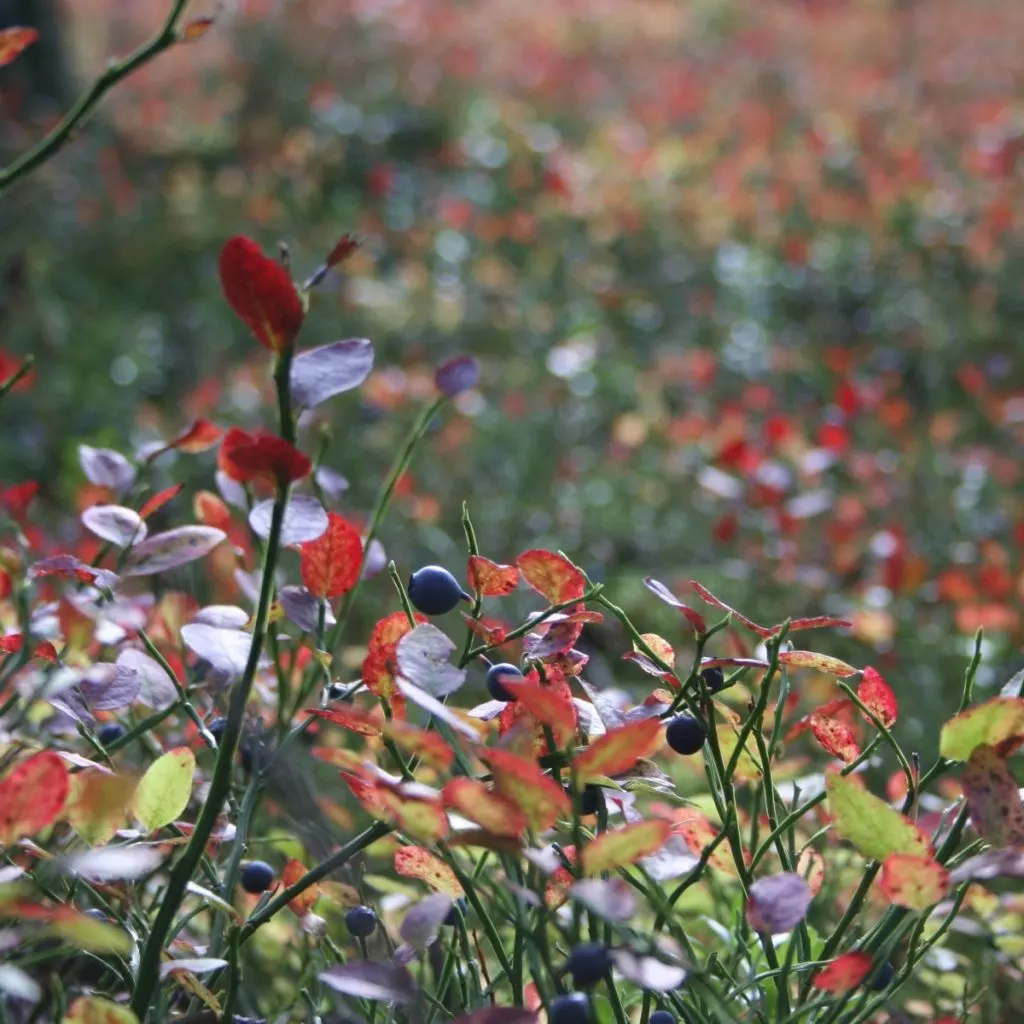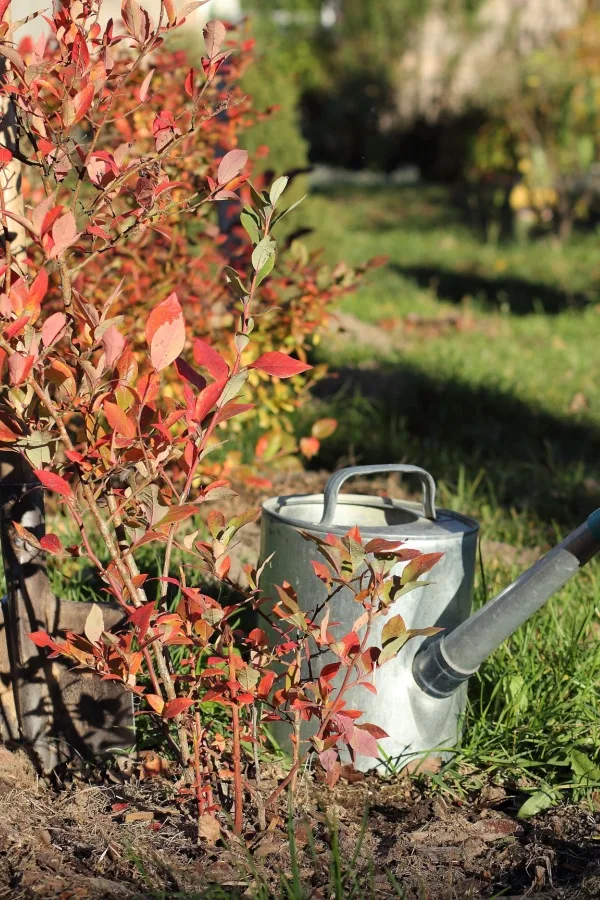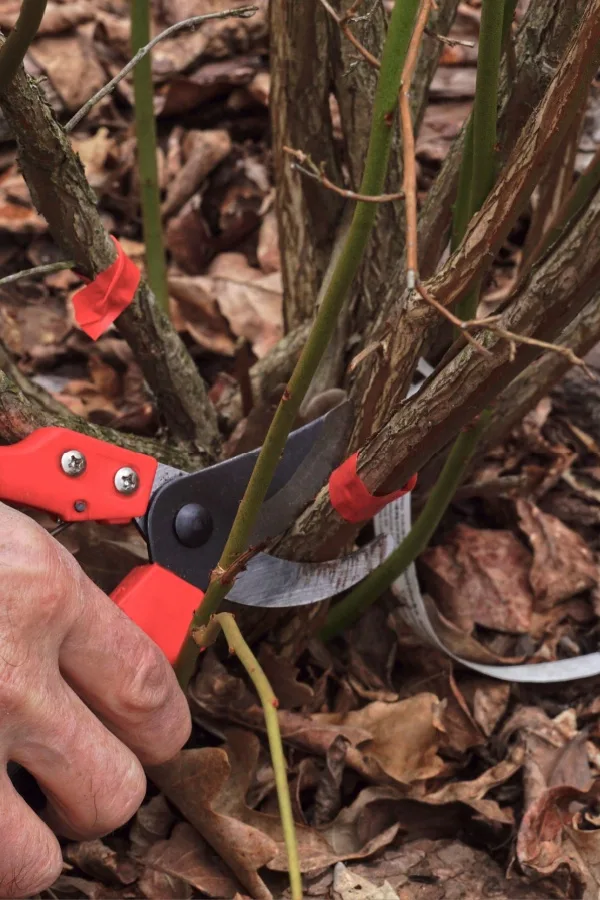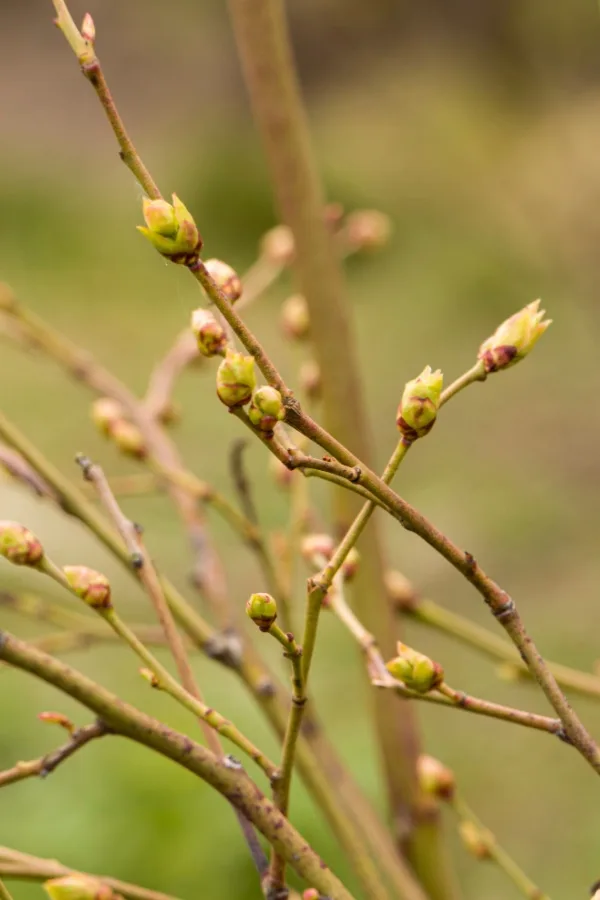Wondering what to do with your blueberry bushes this fall before winter arrives?
Believe it or not, fall is an extremely important time for blueberry bushes. Unfortunately, all too often, once blueberry bushes stop producing in late summer, they are all but forgotten. But as it turns out, how you care for them right before winter arrives can actually make a huge difference in the health of your bushes. And even more – how well they perform and produce next year!
From mulching and pruning, to making sure your blueberry bushes are getting the proper watering they need to store up for good fruiting, one thing is for sure – a little fall care now can pay off big when it comes to your your harvest next year.

What To Do With Blueberry Bushes In The Fall
The Importance of Mulch
Blueberry bushes have very shallow root systems. And there is no better way to help protect those shallow roots through winter than by adding a thick layer of mulch in the fall.
By the time fall rolls around, any mulch that was put down in the spring has likely broken down a bit. Which is exactly why it’s time to add more before the cold of winter arrives! It’s best to always try to keep the mulch between 4 to 6 inches thick all around the root system of your blueberry bushes.
This thick layer will help protect the plants from the thawing and freezing cycles that tend to occur during the winter months.
You can use all sorts of different materials to mulch blueberry bushes. Pine needles, wood chips and pine bark are all great options. Using pine-based materials are perfect for blueberry bushes because they release a bit of acid while they break down – especially green needles! See: How To Use Pine Needles In Gardens & Flowerbeds – And Where Not To!
One final note – when mulching, always be sure to keep the mulch a bit back from the main stems to prevent rot from occurring.
Watering Blueberry Bushes In The Fall
Even though blueberry bushes are done producing berries late in the season, the plants still require moisture in order to stay healthy and alive. This means that you will likely still need to regularly water plants, even when they first go dormant.

During the growing season, blueberry bushes require at least one inch of rainfall or hand watering weekly. The same amount still applies during the fall months as well. In fact, water at this point is crucial for helping the plant store energy for fruiting next year.
It’s best to try to water plants early in the morning or late at night. Water at the base of the plant and avoid watering overhead when possible. This slows evaporation and keeps moisture from sticking to the leaves where mildew and mold can occur. Once the ground freezes, stop watering and resume again in early spring.
Pruning Blueberry Bushes In Late Fall
One of the biggest ways you can help your blueberry bushes in late fall or early winter is to prune them. Pruning not only keeps plants looking tidy, but it helps with the overall health of the plant as well. And to keep your bushes at their best, it needs to be done each and every year once they are a few years old.
When pruning blueberry bushes, you want to wait until the plants are dormant. This doesn’t happen until late fall or even early winter in some climates. You will know that plants are dormant once they have lost all of their leaves.
When you remove a bit of excessive growth along with damaged, diseased, or dead limbs and canes (the fruiting branches of blueberry bushes), you allow the plant to focus its resources and energy on producing new growth once spring rolls around.

Proper pruning also helps to improve air circulation throughout the entire plant, reducing the chances of disease and pest issues. Even more, it keeps blueberry bushes from growing more canes than they can support. While additional canes might sound like a good thing, it often results in smaller fruit and fewer berries.
How To Prune Blueberry Bushes In Late Fall & Early Winter
When it comes to proper pruning, you want to avoid pruning blueberry bushes the first couple of years after planting. This allows the plant to fill out and produce plenty of healthy canes as it establishes in the soil. But after the first couple of years have passed, once it goes dormant, it’s time to get pruning!
With the leaves gone, it’s easy to see which branches need to be cut or removed. Start by looking for any canes that are broken or dead – or weak limbs that might not be able to support the weight of fruit. Use a pair of sharp, clean pruners or loppers and trim these canes all the way back to the ground. Affiliate Link: Fiskars 28″ Steel Blade Garden Bypass Lopper and Tree Trimmer
Next, remove any shoots that are rubbing against one another. This can cause cuts in the wood which might then become affected by diseases or pests. It will also open the bush up a bit more for better air circulation.
Last but not least, look for canes that are drooping and touching the ground, trimming them up to keep the bush’s shape. The overall goal when pruning is to remove about 20% of the older canes, only keeping the healthiest and strongest branches for better fruiting next year.

Why Not To Fertilize – What To Do With Blueberry Bushes In The Fall
Blueberry bushes can benefit from fertilizer in the early spring months to help promote new growth and full foliage. You can also fertilize in late summer around June or July after the plants finish producing.
However, it’s important that you don’t fertilize plants during the fall months. Providing plants with nutrients during the fall will prevent them from entering dormancy. And without proper dormancy, the plants will struggle to stay healthy and protected during the winter months.

Fertilizing too late in the season can also cause new growth to appear on plants. And unfortunately, just in time for the cold weather to arrive. Any new growth at this point has a high probability of winter damage from frost and freezes. And even worse, this can actually put the entire bush at risk of survival.
Instead, hold off on fertilizing until the ground thaws out and new growth starts to appear on plants in the spring. Before you know it, your blueberry bushes will be thriving once again thanks in part to the care you gave it during the fall months!
This Is My Garden
Follow Our Facebook Page For Great Gardening Tips And Advice! This Is My Garden Facebook Page
This Is My Garden is a garden website created by gardeners, for gardeners. Jim and Mary Competti have been writing gardening, DIY and recipe articles and books and speaking for over 15 years from their 46 acre Ohio farm. They publish three articles every week, 52 weeks a year. Sign up today to follow via email, or follow along!
